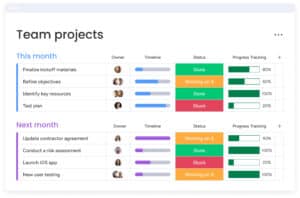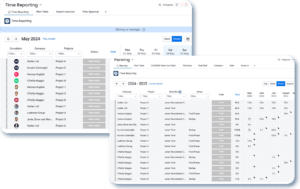Introduction
In the dynamic realm of business, the ability to anticipate the future is akin to possessing a crystal ball. Sales forecasting has always been a critical component of successful business strategies. However, in today’s fast-paced market, it’s more vital than ever. The advent of modern CRM (Customer Relationship Management) tools has revolutionized this process, offering unparalleled insights and precision. In this article, we delve into the world of sales forecasting techniques using modern CRM tools. We’ll explore how these innovative solutions are reshaping the landscape of sales strategy and business growth.
Sales forecasting is not just about predicting numbers. It’s a strategic compass that guides businesses in decision-making, resource allocation, and market positioning. The challenge, however, has always been the accuracy and reliability of these forecasts. This is where modern CRM tools come into play, offering a blend of data analytics, AI, and intuitive reporting to transform sales forecasting from a game of guesses into a data-driven science.
The adoption of sales forecasting techniques using modern CRM tools is no longer a luxury. It’s a necessity in the competitive market. These tools provide a comprehensive view of sales activities, customer interactions, and market trends. Furthermore, they enable businesses to forecast sales with greater accuracy and confidence. Through this article, we will explore how integrating modern CRM tools into your sales strategy can not only improve your forecasting accuracy but also drive business growth and efficiency.
Stay tuned as we delve deeper into the evolution of sales forecasting, understand the role of CRM tools in this transformation, and learn how to harness these tools for your business success.
The Evolution of Sales Forecasting
Sales forecasting has undergone a remarkable transformation over the years, evolving from rudimentary guesswork to sophisticated, data-driven processes. This evolution is a testament to the growing complexity and competitiveness of the business landscape.
From Gut Feelings to Data-Driven Decisions
In the early days, sales forecasting was largely based on intuition and personal experience. Sales managers would rely on their ‘gut feeling’ and historical performance to predict future sales. While this method had its merits, it was inherently limited and often inaccurate. The emergence of sales forecasting techniques using modern CRM tools marked a significant shift from these subjective methods to a more objective, data-oriented approach. CRM systems began to collect and analyze vast amounts of data. In turn, providing sales teams with insights far beyond what was previously possible.
The Role of Technology in Sales Forecasting
The advancement of technology has been a game-changer in the field of sales forecasting. The introduction of CRM tools brought with it an array of features like data analytics, customer segmentation, and predictive modelling. These features enabled businesses to look at their past sales data. Furthermore, it enabled them to analyze current market trends, and customer behaviours, and even predict future sales scenarios. Sales forecasting techniques using modern CRM tools have become more accurate, reliable, and efficient. They allow businesses to make informed decisions quickly and adapt to market changes proactively.
The journey from intuition-based forecasting to relying on sophisticated CRM tools reflects the broader trend of digital transformation in business processes. Today, the use of sales forecasting techniques using modern CRM tools is not just about predicting sales. It’s about gaining a holistic understanding of the market, the customers, and the internal processes that drive sales success. This evolution has empowered businesses to forecast sales with greater accuracy. Additionally, it has enabled them to strategize and plan with a level of detail and foresight that was previously unimaginable.
As we continue to explore the transformative impact of modern CRM tools on sales forecasting, it becomes clear that the future of business decision-making lies in the intelligent use of data and technology. The next sections will delve deeper into how CRM tools are specifically enhancing sales forecasting techniques. Additionally, it’ll cover what businesses can do to leverage these advancements effectively.
Omnitas Newsletter
Sign up for our monthly newsletter to stay up-to-date on our latest blog articles, videos and events!
Thank you!
You have successfully joined our subscriber list.
Understanding CRM Tools in Sales Forecasting
The integration of CRM tools in sales forecasting marks a significant leap in how businesses approach this critical function. To fully appreciate this advancement, it’s essential to understand what CRM tools are and how their features contribute to enhancing sales forecasting techniques.
What Are CRM Tools?
At their core, CRM tools are software solutions designed to manage a company’s interactions with current and potential customers. These tools centralize customer information, streamline sales processes, and improve customer service. But their functionality extends far beyond these basics. Modern CRM tools are equipped with advanced data analytics, AI algorithms, and automated reporting capabilities. This makes them not just tools for managing customer relationships but powerful platforms for gathering and analyzing data that are crucial for sales forecasting. By utilizing sales forecasting techniques using modern CRM tools, businesses can harness this wealth of data to predict future sales trends with remarkable accuracy.
Key Features of CRM Tools for Forecasting
Several features of modern CRM tools are particularly beneficial for sales forecasting. Firstly, data analytics capabilities allow for the processing and interpretation of large volumes of sales data. This helps in identifying patterns and trends that can inform future sales predictions. Predictive analytics is another critical feature. It uses AI and machine learning algorithms to forecast future sales based on historical data and current market trends. Additionally, integration capabilities enable CRM tools to pull in external data sources. For example, market trends, economic indicators, and competitive analysis. These provide a more comprehensive view for accurate sales forecasting. Sales forecasting techniques using modern CRM tools leverage these features to predict sales figures and to understand the factors influencing these predictions. This provides a holistic view of the sales landscape.
The understanding of CRM tools in the context of sales forecasting is crucial for businesses aiming to stay competitive in today’s market. By leveraging the powerful features of these tools, companies can transition from traditional, often inaccurate forecasting methods to more reliable, data-driven techniques.
Advanced Techniques in Sales Forecasting Using CRM
The use of CRM tools in sales forecasting is not just about employing new technology. It’s about embracing a set of advanced techniques that transform how sales predictions are made. These techniques leverage the full power of CRM tools. They incorporate cutting-edge analytics and machine learning to provide a more nuanced and accurate forecast.
Predictive Analytics and Machine Learning
One of the most significant advances in sales forecasting techniques using modern CRM tools is the integration of predictive analytics and machine learning. Predictive analytics utilizes historical data, statistical algorithms, and machine learning techniques to identify the likelihood of future outcomes. This approach goes beyond traditional sales predictions. This is achieved by analyzing patterns and trends to forecast future sales with a higher degree of precision. Machine learning, a subset of AI, further enhances this process by continuously learning from new data. Furthermore, it makes the sales forecasts not only accurate but also adaptive to changing market conditions. By harnessing these technologies, modern CRM tools can provide dynamic, real-time sales forecasts that are closely aligned with the ever-changing business environment.
Integrating Market Trends and External Factors
Another advanced technique in sales forecasting using modern CRM tools is the integration of external market data and trends. Traditional sales forecasting often operates in a vacuum, focusing solely on internal sales data. However, CRM tools now have the capability to integrate external data sources. For example, economic indicators, market trends, competitor activities, and even social media sentiment. This integration provides a more comprehensive view of the market. In turn, this allows businesses to adjust their sales forecasts in response to external factors. It’s not just about looking inward at past sales data but also outward at the broader market landscape. This holistic approach ensures that sales forecasts are data-driven and contextually aware, providing businesses with a competitive edge.
The advanced techniques in sales forecasting using modern CRM tools represent a paradigm shift in how businesses approach this critical function. By leveraging predictive analytics, machine learning, and external data integration, companies can achieve a level of forecasting accuracy and insight that was previously unattainable.
Best Practices for Implementing CRM Tools in Sales Forecasting
Implementing CRM tools in sales forecasting is a strategic move that can yield significant benefits for any business. However, to fully leverage these benefits, it’s crucial to follow best practices in the implementation process. These practices ensure that the sales forecasting techniques using modern CRM tools are effective and seamlessly integrated into the existing business processes.
Choosing the Right CRM Tool
The first step in leveraging sales forecasting techniques using modern CRM tools is selecting the right tool for your business. This decision should be based on several factors, including the size of your business, the complexity of your sales processes, and the specific features you need. Look for CRM tools that offer robust analytics and forecasting capabilities, ease of use, and scalability to grow with your business. It’s also important to consider the tool’s integration capabilities with your existing systems. This ensures a smooth transition and continuous data flow.
Training and Adoption
Once the right CRM tool is selected, the focus shifts to training and adoption. The success of implementing sales forecasting techniques using modern CRM tools heavily depends on how well your team understands and uses the tool. Provide comprehensive training to ensure that all users are comfortable with the new system and understand its capabilities. Encourage a culture of data-driven decision-making, where insights from the CRM tool are actively used in sales planning and strategy. Additionally, gather feedback from users and be open to making adjustments to optimize the tool’s use in your specific business context.
Implementing CRM tools in sales forecasting is not just a technical exercise. It’s a transformative process that can redefine how a business approaches sales strategy. By following these best practices, companies can ensure a smooth transition to a more data-driven, accurate, and efficient sales forecasting model.

The Future of Sales Forecasting with CRM Tools
As we embrace a rapidly evolving business landscape, the future of sales forecasting with CRM tools looks both promising and exciting. These tools, which have already revolutionized sales forecasting techniques, are poised to become even more sophisticated, driven by technological advancements and changing market dynamics.
Emerging Trends and Innovations
The horizon of sales forecasting techniques using modern CRM tools is expanding with emerging trends like AI-driven predictive models, real-time analytics, and increased integration capabilities. We are witnessing the advent of CRM systems that predict sales outcomes and provide actionable insights for strategy optimization. The incorporation of AI and machine learning is becoming more refined. This enables CRM tools to offer not just predictions but also prescriptive analytics – suggesting actions to improve sales outcomes. Additionally, the integration of IoT (Internet of Things) data and the use of advanced data visualization techniques are set to provide even deeper insights into customer behaviour and market trends.
Preparing for the Future
To stay ahead in the game of sales forecasting using modern CRM tools, businesses need to be proactive. This means keeping abreast of the latest developments in CRM technology and continually adapting strategies to leverage these advancements. Companies should focus on building a flexible, data-centric culture, where decisions are made based on the latest insights provided by CRM tools. Investing in ongoing training and development is crucial to ensure that teams are equipped to use these advanced tools effectively. Furthermore, businesses should consider partnering with CRM experts and solution providers who can offer customized advice and support. This ensures that their CRM strategy is aligned with their specific business goals and market conditions.
The future of sales forecasting with CRM tools is not just about adopting new technologies. It’s about embracing a culture of continuous learning and adaptation. As these tools become more integral to sales strategy, businesses that can effectively utilize their capabilities will gain a significant competitive advantage.
Conclusion
As we wrap up our exploration of sales forecasting techniques using modern CRM tools, it’s clear that these tools are not just a passing trend but a fundamental shift in how businesses approach sales strategy. The journey from traditional, intuition-based forecasting to data-driven, technology-enabled predictions represents a significant leap in both accuracy and efficiency.
Modern CRM tools have transformed sales forecasting from a speculative exercise into a precise and strategic process. By harnessing the power of data analytics, predictive modelling, and AI, these tools provide businesses with insights that are not only accurate but also actionable. The integration of external market trends and the continuous evolution of CRM technologies further enhance their forecasting capabilities. This makes them indispensable for businesses looking to thrive in a competitive market.
The key takeaway from our discussion is the importance of adopting a forward-thinking approach to sales forecasting. Embracing sales forecasting techniques using modern CRM tools is not merely about keeping up with technological advancements. It’s about positioning your business for sustainable growth and success in an increasingly data-driven world.
Looking into the Future
As we look to the future, the role of CRM tools in sales forecasting will grow more integral and sophisticated. Businesses that recognize this trend and adapt accordingly will be well-placed to make informed decisions and capitalize on market opportunities. Ultimately, this will drive their sales and growth trajectories upward.
In conclusion, the advancement of sales forecasting techniques using modern CRM tools is a clear indicator of the digital transformation in business. It’s an exciting time for companies willing to embrace these changes, and the potential for improved sales forecasting and business strategy is immense. For those looking to embark on this journey, seeking expert guidance and support in implementing CRM solutions can be a valuable first step towards unlocking the full potential of your sales data.
If you found this blog post useful, make sure to sign up for our monthly newsletter below. Stay in the loop regarding all things business efficiency and automation!
























